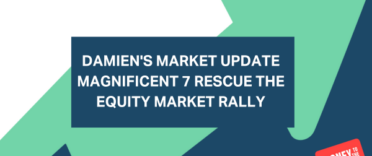Each show lasts between 5-10 minutes and is aimed at DIY investors (including novices) seeking contemporary analysis to help them understand how investment markets work.
Subscribe to my YouTube channel to receive my analysis of investment markets or alternatively, you can listen via my podcast below.
Abridged transcript - Damien's Market Update - August 2024
At the time of my last show, stock markets were riding high, while bonds were slumping, just as we saw the possible beginnings of a Trump trade 2.0, reminiscent of the market movements we’d seen back in 2016.
But a lot has happened in the last month, with most of the catalysts emanating from America.
Disappointing US tech results in the second half of July dampened investors’ appetite, but as we moved into August, the release of two US jobs reports on August 1st and 2nd were enough to spark the stock market sell-off that characterised the first half of August.
These reports revealed unexpected weakness in the US job which triggered fears of a rapid economic slowdown and a possible US recession, which caused US and global stock markets to tank.
Investors’ jitters were compounded by the unexpected interest rate hike from the Bank of Japan, which strengthened the yen and sent Japanese equities into a downward spiral. By August 5th, the Nikkei 225 suffered its worst one-day loss since Black Monday in 1987, falling 12.4%.
As investor anxiety spread globally, the US stock market’s fear gauge, the VIX, spiked to levels not seen since the COVID-19 crash in 2020. The epicentre of this fear was in Japanese equities and US tech stocks. The Nikkei 225 lost over 17% in just two days, dropping 25% below its recent all-time high. The severity of the sell-off in Japan can be attributed to the unwinding of the yen carry trade—a popular strategy where investors borrow yen at low interest rates to invest in higher-yielding assets, principally US Treasuries, stocks and bonds. This strategy was profitable as long as the yen remained weak and Japanese interest rates stayed low. Which had been the case since the early 1990s. The Bank of Japan’s rate hike disrupted this strategy, leading to forced selling, and the unwinding of carry trade positions which caused a ripple effect across global markets. The resulting sell-off hit global markets, particularly tech stocks and other assets that had seen significant inflows from carry trade funds in the past
The timing of this unwinding, during the summer when trading volumes are typically lighter, exacerbated market moves. Analysts debated the potential scale and impact of the carry trade unwind, but there was little consensus.
It meant that in the first 2 trading days of August global stock markets slumped between 3 and 7%, with the Nikkei being the outlier.
Fast forward to today, and stock markets have staged an impressive rebound, with most indices, with the exception of Japan, returning to positive territory for the month.
Strong US retail sales and lower-than-expected inflation data calmed recession fears and fueled hopes for a US rate cut in September, reviving the “Goldilocks” narrative of balanced growth. Gold has unsurprisingly been propelled to new all-time highs thanks to US rate cut hopes.
Seasoned investors will know that strong stock market rallies often follow significant sell-offs, which is what we saw in the first half of August. For instance, after the Nikkei 225 dropped 12% in a single day, it rebounded 10% the next day. These sharp recoveries, known as short-squeezes, occur when investors who are betting on further declines are forced to buy back stocks, driving prices higher, when the market starts moving against them. However, short-squeezes are not always a sign of a sustained uptrend. Markets can still roll over and hit new lows.
But for now, the market angst we saw at the start of August has subsided. For example, the S&P 500 has reclaimed a critical technical level, breaking out of a month-long downtrend, providing a foundation for potential further gains.
After returning from a brief trip away with the family, I can genuinely recommend taking a break during a stock market downturn. Although it might seem counterintuitive for investors who habitually monitor their portfolios, stepping away could prevent rash decisions driven by market noise. Research suggests that such a strategy could benefit not only your mental well-being but also your financial health.
In 2015, I conducted research on how best to navigate a stock market slump. The findings indicated that while no strategy is foolproof, history suggests staying invested after a significant market correction is often the better choice. Reacting impulsively to market declines can lock in losses and cause you to miss the subsequent recovery. This is precisely where we found ourselves in early August—amid a market downturn following a brief period of weakness.
So far August has provided some valuable lessons for both new and experienced investors:
- Be cautious of consensus narratives.
- Avoid panicking and making emotional decisions during market sell-offs.
- Refocus on your investment strategy and long-term goals.
- Remember that short-squeezes often follow major sell-offs, and those who panic can miss out.
- And finally, if all else fails, take a holiday—it can provide much-needed perspective.



